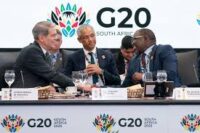The World Food Programme (WFP) has announced drastic reductions in food aid for hundreds of thousands of refugees living in Kenya, citing a sharp decline in global humanitarian funding, including significant budget cuts from the United States Agency for International Development (USAID). The cuts have already taken effect in the sprawling Kakuma and Dadaab refugee camps, leaving residents facing severe shortages and triggering protests over who will receive food and who will go without.
According to the United Nations High Commissioner for Refugees (UNHCR), Kakuma and Dadaab together host nearly 800,000 people most of them having fled devastating conflict, prolonged drought, and instability in Somalia and South Sudan. For years, these camps have depended almost entirely on international aid for food and essential supplies. However, WFP’s deputy country director in Kenya, Baimankay Sankoh, confirmed that dwindling resources have forced the agency to introduce a controversial “priority food distribution” system that allocates aid based on assessed vulnerability rather than refugee status.
Under this new system, the most vulnerable groups, including pregnant women, people living with disabilities, and those with no income, are receiving 60% of the standard ration. Refugees with some form of income have seen their food support cut by as much as 80%. WFP officials say the shift is necessary to stretch dwindling stocks, but the changes have fueled anger among camp residents, some of whom now receive no food assistance at all.
Tensions have been building in recent weeks, with refugees staging demonstrations to protest the cuts. Last week, these tensions erupted into violence, leaving one person dead and several others injured. “People were very angry about the new distribution system,” reported Al Jazeera’s Catherine Soi from Kakuma, noting that residents feel they are being forced into an impossible situation where survival is no longer guaranteed.
WFP’s Thomas Chica explained that the system was rolled out after detailed assessments by WFP and its partners to determine individual needs. “We need to look at refugees separately and differently and see how best we can channel the system so that it provides,” Chica said. Yet the reality on the ground remains grim: the Global Acute Malnutrition (GAM) rate among refugee children and pregnant or breastfeeding women in Kenya is over 13% far above the 10% threshold that constitutes a nutrition emergency.
Even before the cuts, rations were already low, with most refugees receiving just 40% of the recommended daily caloric intake of 2,100 kcal. With more people now sharing these reduced rations, food stocks will not last as long as planned. WFP estimates that, with current funding, they will only be able to sustain assistance until December or January. In May, the organisation said it needed an additional $44 million to restore full rations and cash aid for all refugees through August alone a target that has not been met.
As the crisis deepens, humanitarian agencies warn that the situation in Kakuma and Dadaab could worsen rapidly without urgent donor support. For many refugees who have already endured years of displacement, these cuts represent not just a reduction in meals, but a devastating blow to their hopes of survival and dignity.














Leave a comment